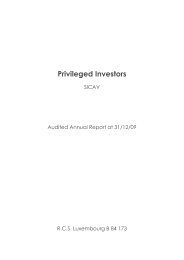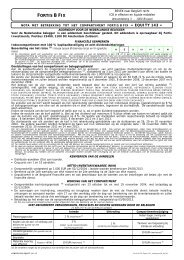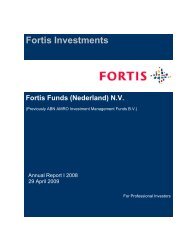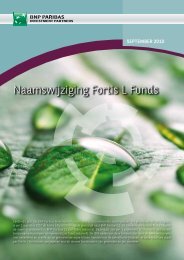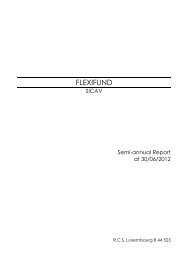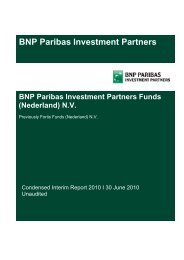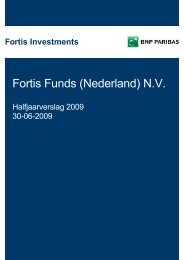here - BNP Paribas Investment Partners
here - BNP Paribas Investment Partners
here - BNP Paribas Investment Partners
- No tags were found...
You also want an ePaper? Increase the reach of your titles
YUMPU automatically turns print PDFs into web optimized ePapers that Google loves.
For professional investors – July 2012Going for GoldGlobal Listed RealEstateMID-YEAR OUTLOOK 2012
Global Listed Real Estate Mid-year Outlook 2012 | July 2012 – 2T<strong>here</strong> is clearly a sense of déjà-vu for many market participants at the midpoint of 2012 as we remain confronted by many of the concerns that werepresent this time 12 months ago and which have the potential to generate a re-run of the market turmoil of the summer of 2011. The market hasbeen very macro-dominated and policy events and political gatherings have increasingly become a focus of market attention. What is more, theglobal economy is slowing down at the halfway point of the year as the eurozone crisis is becoming a drag on other parts of the world. So far thisyear, it has been a testing time for equity markets, particularly since March. Despite the less-than-promising policy background, global real estatehas outperformed general equities so far this year.One emerging theme is the way that US REITs and individual investors are increasingly looking to the world’s major cities like New York, London,Singapore and Tokyo to find growth and as a safe haven for their capital. This develops a trend we identified at the end of 2011: that t<strong>here</strong> was agrowing propensity for higher income households to concentrate in cities and regions and the implications this carries for commercial real estate.THE MARKET IN 2012We were cautiously optimistic about the prospects for real estate at the start of 2012 and the reasons for optimism have broadly been justified.Despite the increasingly uncertain macroeconomic and policy backdrop, real estate stocks have outperformed and global property is positive year todate.Global real estate total returns year to date (local currency)JapanSingaporeGermanyGlobal real estateAustraliaUSUKHong KongFranceSwitzerlandCanadaNetherlandsSweden0 5 10 15 20 25 30Total return year to date in %Source: FTSE EPRA NAREIT, DataStream, 29.6.2012Global markets are up 17.9% (FTSE EPRA NAREIT Global Index, Bloomberg 21.6.2012), well ahead of general equities. The main driver for returnshas been the strength of North American and Asian markets. The US is up more than 17% YTD (in euros) while the Asia Pacific index has returned16.1% YTD (in euros). Despite ongoing concerns about the stability of the eurozone, European real estate (EPRA index) has returned 13.3% YTD.As expected, some investors have turned to property stocks as a source of safety for a variety of reasons during the year. Real estate companiesbenefit from a number of features which we felt would help them sustain positive returns in 2012 and have helped contribute to the sector’soutperformance thus far this year. The sector is in a better position than its peers in the non-listed real estate segment and is in better shape thanbefore the onset of the global financial crisis in 2007. Broadly speaking, global real estate companies benefit from:- Owning high quality assets- Being bond proxies with offering an attractive risk premium- Possessing improved capital structures and having sufficient access to capital markets- Being income-producing businesses with strong cash flows- Having a generally positive relationship between supply and demand in their core direct property markets in developed real estate marketsaround the world
Global Listed Real Estate Mid-year Outlook 2012 | July 2012 – 3Difference between listed real estate dividend yields and Government bondsYield spread to bonds in bpsCurrent spread700Historic average600500400300200100--100-200-300NetherlandsBelgiumFranceSwitzerlandCanadaFinlandSwedenAustraliaUKNorwayHong KongItalySingaporeUSAJapanAustriaGermanySpainChinaSource: Bloomberg, 21.6.2012The prevailing macro conditions have generated a policy environment of low short and long-term interest rates that has benefited listed real estatecompanies with good access to the capital markets. The spread of real estate equity yields to government debt is around 200bp in the US and Japanand is considerably above the historical averages.Investors have been looking for safety and quality in trying to avoid contagion from any major fallout from the debt crisis in Europe. As a result, t<strong>here</strong>has been a surge of capital into US and German government debt, which has led to Treasury and Bund yields compressing by 24bp year to date(21.6.2012), while Australia has seen a 53bp compression. In contrast, Spanish government bond yields have risen 159bp over the same period(source: Bloomberg).In the equity world, real estate is viewed as a bond proxy. It is high yielding, clearly less expensive than public debt and while obviously carryinghigher risk, offers higher income security in the current climate than equities in general. Investors have been cautious about investing in Europeanfinancials and those with a large European exposure. REITs and property companies are viewed as financial stocks and investors have turned tothese companies for their exposure to this sector.A number of investors have also looked at property stocks, notably in the US, because of their domestic bias. Property companies tend to befocused on home markets; few of them invest significant amounts internationally. As a result, US investors in particular have sought safety byinvesting in US REITs, which, with a few exceptions, are exclusively focused on North America. In contrast, if one buys French or Dutch retail REITstocks, these companies have exposures to the eurozone’s periphery, which the majority of the market has been trying to avoid for the past 12months.Another factor that has played out in favour of real estate companies is that the type of assets they typically own is related to the renewal in balancesheet strength. Companies in North America have reduced their leverage since the height of the financial crisis by raising equity, selling non-coreassets and re-financing their loan books. As a result, gearing levels have dropped substantially in the US. Australian companies have followed asimilar script.REITs and property companies have benefited by being able to access the capital markets when they have needed to, to acquire new assets andborrow at relatively favourable rates. This contrasts with the more limited ability of the private real estate market to access debt and equity atfavourable capital rate costs to make acquisitions.Globally, the sector still looks attractively priced, with property companies offering a large spread to government debt and trading at a substantialdiscount to NAV. Earnings growth prospects look positive, with the sector expected to deliver solid dividend growth over the next 12 months. Clearlyt<strong>here</strong> is a risk that earnings cannot match historical levels or current expectations if the economy weakens, but the lease structures that real estatecompanies enjoy with their tenants ensure that a large proportion of future cash flow is guaranteed, which implies that a proportion of future earningsis protected.
Global Listed Real Estate Mid-year Outlook 2012 | July 2012 – 4THE OUTLOOKPOLICY MEASURES FOR MACROECONOMIC PRESSUREIn the short to medium term, we expect policy decisions to remain one of the key catalysts of real estate and broader capital market behaviour overthe next 12 months. Decision-makers in Washington DC and New York, Berlin and Frankfurt, Beijing and Tokyo, will be the main architects of marketsentiment in the coming year.T<strong>here</strong> is little we can add to the millions of words that economists and policy commentators have spent on analysing the eurozone’s every step. Themarket considers that parts of the region’s banking system could be vulnerable and in the absence of significant steps to address bank weaknessacross the region and thus restore faith in the financial system, we expect the euro crisis to be a perennial subject. As we noted at the end of lastyear, if the euro does fail, real estate will not escape. Equally, we still hope the EU policymakers and politicians can conjure up a near-term solutionto the seemingly intractable and increasingly grave problems of the monetary union.Needless to say, as soon as the EU summits close the first half of 2012, the market will switch its attention to the fiscal crisis in the US. The deficitceiling will be revisited as the so-called fiscal cliff starts to grab the headlines. In January 2013, the US faces a combination of tax increases andspending cuts, which may lead the economy back into recession. The concern is that the US will embark on a fiscal squeeze that economistsestimate will be between 3.5% and 4% of the country’s GDP. If the worst comes to the worst, this could lead to austerity levels not seen since 1969,when it resulted in a recession. Whether this will happen in practice remains to be seen, as the political situation remains unpredictable in an electionyear.Japan has also seen a fundamental shift in policy–making, with long-term implications for the broader economy. The Bank of Japan (BoJ) hasembarked upon a policy of targeting higher inflation. This, in turn, should result in a weaker yen. The policy has been pursued via monetary easingthrough the central bank. The BoJ has thus far pumped liquidity into the Japanese market which has had the effect of lowering the yen against theUS dollar and euro. However, as the year has progressed, the yen has strengthened. Looking ahead, whether the BoJ can act effectively tostimulate inflation, lower the currency and thus boost Japanese exports and growth, remains to be seen.THE GLOBAL ECONOMY: SLOWING BUT NOT SINKINGThe global economy looks set to soften in the second half of the year. The eurozone crisis has undermined producer and consumer sentimentacross the world, and GDP growth looks vulnerable. Growth looks set to be below trend in the second half of the year and into 2013. Deleveraging inEurope is underway and with the US likely to undergo some form of public spending adjustments, while China’s growth slows in response to fallingdemand in Europe and North America, the immediate outlook has few catalysts to spark a global economic revival.Not surprisingly, expectations for global economic growth have weakened. China is forecast to grow at close to 8%, with some economists beginningto see growth of less than 7%, well below trend. US growth expectations have also weakened, with output expected to rise by just above 2% overthe next two months. While Japan should grow more rapidly than recent trend rates of growth, the eurozone looks set to slip into official recession,with even Germany’s export-led economy facing a slow down.
Global Listed Real Estate Mid-year Outlook 2012 | July 2012 – 5GDP growth forecasts – 12 months to Q2 2013 versus trend1210GDP growth in % per annum8642--2-4Source: Consensus economics, June 20121 Year Forecast TrendDIRECT PROPERTY MARKETSWhile the macro front has been disappointing, t<strong>here</strong> has been plenty of encouragement in the direct property markets, especially in Asia and the US,but also in select parts of Europe.● AsiaHouse prices in China had been falling across the major cities in 2012 until a very marginal improvement in June, while, in contrast, prices in HongKong have continued to rise. While home sale volumes have started to ease in Hong Kong and luxury price levels stabilised at the end of the firstquarter, the demand has been so strong year-to-date that prices have continued to rise, with the market up 10% YTD at the end of May. In thesecond-hand apartment market, prices of used homes in Hong Kong are the highest they have ever been, according to the Centa-City LeadingIndex, which tracks secondary market homes and shows prices of flats in the city rose in May to surpass the previous record of October 1997.Hong Kong’s office market has weakened during the year, particularly in the prime markets of the Central and Admiralty areas, w<strong>here</strong> higher supplyand the worsening global economic outlook have dampened rental growth. Agents DTZ said rents in Central and Admiralty declined 10% across theboard in the first half of the year, but the rate of decline slowed in the second quarter. In the decentralized office markets rents have risen in the firstsix months of the year as have capital values.Japan’s office market, which is a key focal point for the country’s listed real estate companies and JREITs, has begun to show signs of stabilisationat the midyear point. The market had anticipated rising vacancy as new supply came into the market in the central wards of Tokyo’s central businessdistrict (CBD). The Miki Shoji Tokyo overall office vacancy rate stood at 9.4% at the end of June and is expected to move slowly downwards in thesecond half of the year, as existing and newly built supply is occupied.The Australian property market is relatively stable and has had a mixed year. The residential sector has been weak, with house prices falling in NewSouth Wales and Victoria. In the office sector, office fundamentals have deteriorated in the major CBD markets of Sydney and Melbourne asemployment growth has slowed in the business and financial sectors. Retail property has been hit by weakening consumer confidence and growingcompetition from internet. Sub-regional malls and secondary shopping centres have been particularly sluggish in the face of slower retail salesgrowth.● The USAlthough the US economy was slowing at the end of Q2 2012, tenant demand is moving in the right direction. What is more, the relatively low supplyrates mean below-trend growth levels will be positive for most sectors and occupier markets. Fundamentals are improving in every sector in the US,
Global Listed Real Estate Mid-year Outlook 2012 | July 2012 – 6with low supply a feature of all major real estate types. The outlook for income growth is t<strong>here</strong>fore positive for apartments and malls in particular,according to analysts, Green Street.As in other parts of the world, prime property has tended to be the more sought-after by both tenants and landlords. In terms of retail, higher incomegroups have been impacted less severely by the consequences of the 2007 financial crisis and have seen their finances recover more rapidly.Consequently, REITs with exposure to these types of consumers via their retail portfolios have responded more comfortably and substantially.As well as improved levels of demand, supply levels have been subdued, which will help improve occupancy levels. Indeed, real estate researchagencies like REIS Inc are forecasting that vacancy rates will improve across the major US property sectors as a result of this healthy relationshipbetween demand and supply.The polarisation between primary and secondary/tertiary locations is most developed in the office sector, w<strong>here</strong> CBD locations are outperformingsuburban locations in terms of improving fundamentals, reflected in increased demand, improving occupancy rates and rental growth. The CBDcoastal markets (New York, San Francisco) are expected to continue to outperform as demand is solid and new supply very limited.● EuropeAn increasing dichotomy in the performance of direct markets across Europe has been evident so far in 2012 and will become more pronouncedover the next 12 months. Investors are looking at high demand markets in Europe’s strong economies and are almost exclusively focused on primeproperty with long leases. The eurozone peripheral markets have been ignored as investors focus almost exclusively on Germany, the UK and theNordic countries. CBRE data suggest that commercial property transactions in Greece, Spain, Italy, Portugal and Ireland have fallen by two-thirdsover the past year. The value of deals has fallen 90% since 2007, when the commercial property market was at its peak.As well as the shift in geographical emphasis, t<strong>here</strong> have been shifts in focus between and within real estate sectors. All property sectors areundergoing severe changes. Retail is being reshaped by economic forces as well as changes in shopping behaviour. UK retail, for example, hasbeen at the forefront of the shakeout, with shopping centre values falling sharply in May. The decline was 1.3% since the start of the year (IPD) withshop vacancies across the UK as a whole at 14.5%, (figures from Local Data Company).Germany’s property market has been a solid performer through 2011 and into the first half of the year. Demand for all sectors has been resilient,reflecting the solidity of the underlying economy and the extent of demand from occupiers. While the market is better placed than much of theeurozone, the outlook looks less certain. The office and residential sectors have seen significant investment volumes since 2011. Demand forshopping centres in Germany has been boosted by the improved retail outlook. International retailers will continue to seek to expand their presencein Germany, which will drive demand for space in shopping centres. Rents have been strong in 2012 and as a result have increased 4%-8% over thelast 12 months. Despite rising supply, this demand from retailers should help maintain rental levels in the best shopping centres.The French property market looks over-priced relative to Germany and the UK, given the current pricing and expected growth for the medium term.Property yields in the Paris office market have been firm thus far this year, but the waning of investor demand may begin to place downwardpressure on property values. In the retail segment, t<strong>here</strong> are challenges ahead, not least managing the impact of lower consumer spending aseconomic weakness and austerity begin to bite. T<strong>here</strong> is also the impact of online retailing to be managed.
Global Listed Real Estate Mid-year Outlook 2012 | July 2012 – 7The average yield for office transactions7.5Yield in %7.06.56.05.55.04.54.0Jan‐09Mar‐09May‐09Jul‐09Sep‐09Nov‐09Jan‐10Mar‐10May‐10Jul‐10Sep‐10Nov‐10Jan‐11Mar‐11May‐11Jul‐11Sep‐11Nov‐11Jan‐12Mar‐12Source: Real Capital Analytics, Bloomberg. June 2012.London New York TokyoGOING FOR GOLD: HOW LONDON AND GLOBAL CITIES BENEFIT FROM THE FLIGHT TO QUALITYAcross the spectrum of real estate, investors are looking to the world’s major cities like New York, London, Singapore and Tokyo, as well as marketslike Vancouver, which can offer both growth potential as well as safe havens for their capital. Both US REITs and individual investors are looking forhigh quality opportunities in safe havens to acquire prime assets.A theme we return to, and that we highlighted in the 2012 outlook, is the growing concentration of higher educated, higher income households in themost sought-after neighbourhoods within cities and sub-regions, and the implications this has for owners of commercial real estate. Investors lookset to continue the search for high-quality and less risky destinations for their capital. The flight to quality reflects some of the socio-demographicchanges that have been accelerating in developed and emerging markets, and upon which REITs and individual investors are also focusing, eit<strong>here</strong>xplicitly or indirectly, in their investment strategies.What we are witnessing in major urban areas across the world is nothing new, as neighbourhoods become more homogenised in terms of incomedistributions. As Plato observed: “Any city, however small, is in fact divided into two, one the city of the poor, the other of the rich”. Nevertheless, thephysical and income divide between the wealthy and the rest of society is likely to remain a feature of urban life for the foreseeable future and tobecome increasingly prominent in real estate investors’ portfolios; it is likely to drive investors to seek markets w<strong>here</strong> they can find largeconcentrations of high-income households.Investors are focusing more and more on dominant markets. In Europe, we have seen a number of US investors, pension and sovereign wealthfunds focusing on the London market. Brookfield Office recently purchased a portfolio of office assets. Equally, other US public companies havestated that they will be looking to enter the UK, principally the London market. Japanese developers like Mitsui Fudosan have also indicated thatthey will be trying to strike deals in the London office market. While the UK is struggling to emerge from the impact of the financial crisis and facesyears of economic restructuring and austerity, London’s economy is seen as increasingly independent from the rest of the country and set to benefitfrom its position of one of the world’s top financial centres.The disparity between London and the rest of the UK is illustrated by rental growth forecasts from real estate agent, Jones Lang LaSalle. Theyforecast UK rental growth will be 1.4% a year over the next five years, while they expect London West End and City offices to average 4.9% growthannually over the same period, as t<strong>here</strong> is not enough supply of prime stock to match demand from occupiers and investors.The move towards global cities or dominant global regions by property groups is matching a trend among rich individuals, and particularly amongwealthy Chinese investors. According to the Shanghai branch of real estate service provider, Colliers International, London, Vancouver, Toronto andSingapore will become the most popular destinations for Chinese property investors. According to this analysis, more than 20% of foreign investorsin these four cities are already Chinese.
Global Listed Real Estate Mid-year Outlook 2012 | July 2012 – 8CONCLUSIONIn truth, as we survey the world, the political and macro environment has fluctuated continuously, but is largely unchanged since the start of the year.European politicians may continue to be divided about the steps required to deal with the fiscal and financial market imbalances in the region, but thecapital markets are clearly no longer prepared to postpone the day of reckoning.Turning attention to the real estate sector, we have more cause for optimism. We are still contemplating a soft landing in China, while the US macroenvironment has entered a renewed period of uncertainty. Direct markets have held up reasonably strongly year to date, but could become morevulnerable to the stress imposed by a deteriorating policy and a weakening macroeconomic environment. Nevertheless, we expect high qualityassets and prime markets to remain less exposed to deteriorating macro conditions. Higher-end properties in markets with high barriers to entry, willcontinue to outperform, and the REIT and listed commercial property sector generally benefits from that. Property stocks look attractively pricedversus direct market prices and benefit from owning higher quality assets in superior locations; they enjoy strong balance sheets and largelyunrestricted access to the capital markets. Solid underlying occupier and investment market conditions underscore attractive valuations, with thesector trading at a substantial discount outside of the US. Cap rates offer a spread over government debt of 200bp to 300bp.Listed real estate share prices have appreciated impressively in 2012, but we still believe t<strong>here</strong> is upside for the sector property as a whole in 2012assuming the risks from a further downward spiral in the eurozone do not materialise. We expect Asia Pacific to deliver the best growth prospectsand have a large overweight to Japan which we believe will benefit from the continuing recovery from the aftermath of the 2011 earthquake. Similarlyin Hong Kong, growth expectations are relatively good, with our preference for the development oriented companies over the REITs. In Europe ourpreference lies with the UK and Nordic markets. North America is the largest underweight with valuations looking stretched in both markets.Total expected returns – consensus estimatesNetherlandsJapanHong KongSwedenFranceSingaporeUKGlobalGermanyUSAAustralia‐ 5 10 15 20 25 30Estimated total return in % p.a.Source: Bloomberg, <strong>BNP</strong>, Consensus estimates. June 2012
Global Listed Real Estate Mid-year Outlook 2012 | July 2012 – 9DISCLAIMERThis material is issued and has been prepared by <strong>BNP</strong> <strong>Paribas</strong> Asset Management S.A.S. (“<strong>BNP</strong>P AM”)* a member of <strong>BNP</strong> <strong>Paribas</strong> <strong>Investment</strong><strong>Partners</strong> (<strong>BNP</strong>P IP)**.This material is produced for information purposes only and does not constitute:1) an offer to buy nor a solicitation to sell, nor shall it form the basis of or be relied upon in connection with any contract or commitment whatsoeveror2) any investment advice.Opinions included in this material constitute the judgment of <strong>BNP</strong>P AM at the time specified and may be subject to change without notice. <strong>BNP</strong>P AMis not obliged to update or alter the information or opinions contained within this material. Investors should consult their own legal and tax advisors inrespect of legal, accounting, domicile and tax advice prior to investing in the Financial Instrument(s) in order to make an independent determinationof the suitability and consequences of an investment t<strong>here</strong>in, if permitted. Please note that different types of investments, if contained within thismaterial, involve varying degrees of risk and t<strong>here</strong> can be no assurance that any specific investment may either be suitable, appropriate or profitablefor a client or prospective client’s investment portfolio.Given the economic and market risks, t<strong>here</strong> can be no assurance that any investment strategy or strategies mentioned <strong>here</strong>in will achieve its/theirinvestment objectives. Returns may be affected by, amongst other things, investment strategies or objectives of the Financial Instrument(s) andmaterial market and economic conditions, including interest rates, market terms and general market conditions. The different strategies applied tothe Financial Instruments may have a significant effect on the results portrayed in this material. The value of an investment account may decline aswell as rise. Investors may not get back the amount they originally invested.The performance data, as applicable, reflected in this material, do not take into account the commissions, costs incurred on the issue andredemption and taxes.*<strong>BNP</strong>P AM is an investment manager registered with the “Autorité des marchés financiers” in France under number 96-02, a simplified joint stockcompany with a capital of 64,931,168 euros with its registered office at 1, boulevard Haussmann 75009 Paris, France, RCS Paris 319 378 832.www.bnpparibas-am.com.]** “<strong>BNP</strong> <strong>Paribas</strong> <strong>Investment</strong> <strong>Partners</strong>” is the global brand name of the <strong>BNP</strong> <strong>Paribas</strong> group’s asset management services. The individual assetmanagement entities within <strong>BNP</strong> <strong>Paribas</strong> <strong>Investment</strong> <strong>Partners</strong> if specified <strong>here</strong>in, are specified for information only and do not necessarily carry onbusiness in your jurisdiction. For further information, please contact your locally licensed <strong>Investment</strong> Partner.



